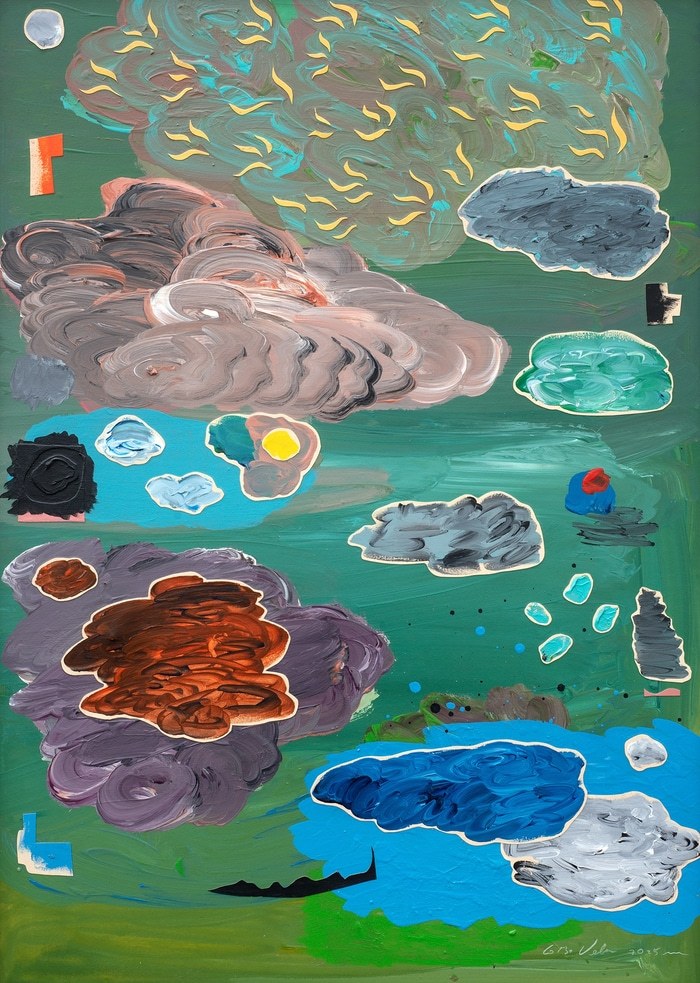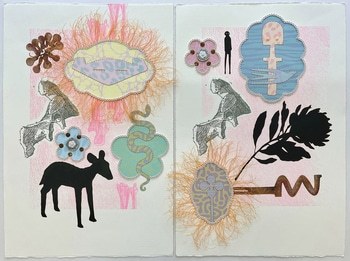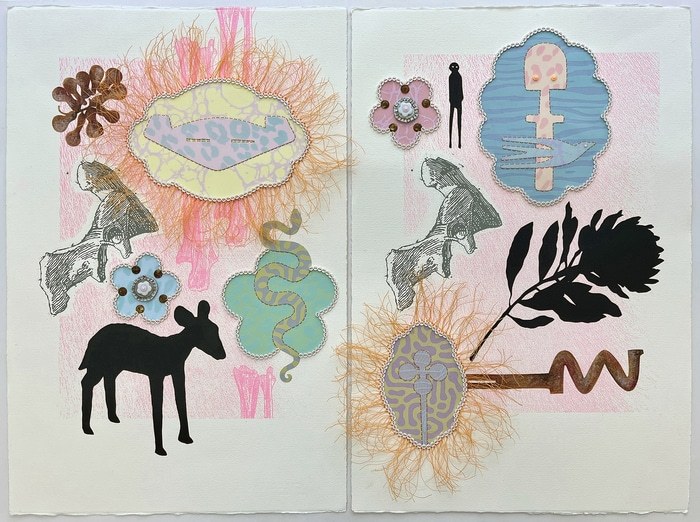Browse thousands of original art prints for sale online today. Our online collection showcases limited edition prints from some of the most exciting artists active today. We have curated a diverse selection, whether you’re on the hunt for a new botanical print, or looking to purchase a portrait. Discover styles ranging from Abstract to Art Deco.
Bruce McLean is one of Britain’s most renowned contemporary artists. Bruce’s use of vibrant and bold colours in his prints created by the monograph technique defines his signature style and establishes his position as an acclaimed printmaker. At Rise Art, you can find many of Bruce McLean’s prints for sale. Our current favourite is There’s a Sculpture in my Profiteroles (2011), created using layers of bold colour and intricate detail to establish a playful narrative scene.
Katutoshi Yuasa creates beautiful woodcut prints such as CMYK#2 (2016). Katutoshi has merged the traditional technique of woodcutting with digital photography. By combining two processes – the camera’s ‘snapshot’ and the woodcut’s lengthy reinterpretation of the same image – he hopes to crystallise the atmospheric and emotional nature of his subjects.
British artist Antony Gormley has constructed beautiful lithographs that are in direct connection with the sculptures and installations that made him famous. You can find similarities between the vague human figures Antony often sculpts and his prints such as Free or Untitled (Some of the Facts, both depicting black human figures. His work, whether in his sculptures or his prints, has a critical approach to the body and its relation to the space that surrounds it.
Alexandra Gallagher’s trippy, fairytale portraits combine delicate femininity with bold floral prints to create unique contemporary feminist art. Using Photoshop, the artist digitally collages female nudes with art historical landscapes, flora, fauna and humorous typography. In Gallagher’s print Do What Makes You Fizz (2023), the artist layers neon words through a vibrant bouquet of flowers to create a tongue-in-cheek design.
Pablo Picasso, although mostly famous for his paintings, produced many prints. Whether expressionistic, figurative or cubist, you are sure to find what you like if you are interested in the works of the Spanish artist. Pablo Picasso created many portrait prints of people around him, like his daughter or other artists, such as musicians.
Award-winning conservation and wildlife artist Sophie Green creates many photographic prints that put animals front and centre. In her animal portraits prints, Sophie Green communicates a powerful message about how we perceive animals, for example Grace, which represents a beautiful peacock, a symbol of beauty in the animal world as well as ours. However, she also puts out artworks with political messages such as Broken, picturing an elephant with broken tusks, which could be a critique of elephant tusks traffic.
Discover more of our printmakers here.
Print Styles For Sale
Prints and printing techniques have developed for many years across the world. Printing is the act of transferring an image or text onto another material. As printing techniques, such as woodcut, linocut, screen, monograph and 3D printing have developed, artists have gained greater creative freedom in the medium.
Woodcut printing is viewed as one of the oldest forms of printing, originating in China over 1,000 years ago. Originally, wood lettering and symbols were individually cut out, dipped in ink and then pressed onto materials to transfer the subject onto paper. By the 15th century, woodcut blocks were developed for whole images or texts to be carved, ink spread and then reproduced onto paper. Katushika Kokusai’s Fine Wind, Clear Morning (1830-1832) is a classic woodblock print illustrating Mount Fuji. The coloured ink of red, blue, white and black captured by the woodblock engravings creates a minimalistic design that remains an iconic Japanese print.
Buy woodcut prints
In the 20th century, linocut was developed by cutting into sheets of linoleum. The material of linoleum is a light and smooth metal sheet and its easy carving allows artists greater freedom to create a wide range of lines. Artists such as Henri Matisse used linocut and the technique of carving with a knife to create innovative pictorial compositions with simple lines that abstracts and distorts the subject's form. This technique enabled Matisse to create beautiful figurative linocut prints of dancers and faces.
Buy linocut prints
Screen printing is a printing technique in which the artist uses a mesh to transfer ink onto new material, such as paper or canvas. Whilst screen printing has been around since the 1700s, it was the artist Andy Warhol who popularised the technique amongst artists. Throughout the 1960s, Warhol created bold and vibrant prints of mass culture from Campbell Soup to the popular actress Marilyn Monroe. Warhol chose the technique because he wanted to remove the artistic touch in creating artwork and challenge high art. However, Warhol’s screen-prints have become a distinct style that has remained influential throughout the development of modern art.
If you wish to observe Andy Warhol’s signature technique and style, you can find one of his famous Marilyn Monroe prints on our website. Andy Warhol also made prints of political figures such as Mao Tse-Tung and Advertising Flyer for the Mao Tse-Tung Portfolio, using the same renowned visual identity that made him a legendary artist.
Japanese artist Takashi Murakami also often uses linocut printing for his vibrant prints, creating beautiful renderings of flowers, cartoon characters and portraits. Having gained popularity for his brightly coloured style and recognisable style inspired by cartoons, Takashi Murakami offers a wide range of prints that will brighten up any environment!
Buy screen prints
Unlike other printing styles, monoprints cannot be reproduced. The print is created from a material such as a carved woodblock or etched lithograph, yet the substances used to print the block have only one printing capacity. Old masters such as Rembrandt and Impressionists such as Edgar Degas have used this technique to create one-off prints for artistic innovation. Degas manipulated the properties of ink when placing it on an etched metal plate and sandwiched through the press with paper. His use of this medium allowed him to experiment with creating new forms and tones that would be incorporated into his paintings.
Buy mono prints
Why and How to Choose a Print?
Whether it’s an abstract burst of colour, a delicate botanical design, or a bold portrait, a print has the power to transform a room and stir your imagination. It’s about finding that piece that stops you in your tracks, the one that makes you feel something every time you walk by.
Choosing a fine art print lets you bring home a piece of the artist’s vision, capturing emotions, stories, and moments in time. It’s an affordable way to own original art while supporting talented creators. Limited editions add a touch of exclusivity, making each print a treasured possession shared by only a few.
When selecting a print, trust your intuition. Let yourself be moved by colours, shapes, or scenes that resonate with you. Think about where it will live – a serene landscape can bring calm to a bedroom, while a vibrant abstract can energise a living space. Whether framed or unframed, a print adapts to your style, adding character and depth to your home. Explore our collection of original art prints for sale and find the piece that speaks to you. Let your walls echo your story.
To discover more about printmaking, have a look at our Guide To Prints.















![Sam. [Portrait of a purple cat with yellow eyes.] by Andy Warhol](https://d1ee3oaj5b5ueh.cloudfront.net/thumbs/350xAUTO_processed_art_2023_12_f209f585-8715-4ee0-8a74-712a24369b29-main-master.jpeg)
![Sam. [Portrait of a purple cat with yellow eyes.] by Andy Warhol](https://d1ee3oaj5b5ueh.cloudfront.net/thumbs/700xAUTO_processed_art_2023_12_f209f585-8715-4ee0-8a74-712a24369b29-main-master.jpeg)















![Sam & Sam. [Yellow cat and kitten with orange eyes laying down.] by Andy Warhol](https://d1ee3oaj5b5ueh.cloudfront.net/thumbs/700xAUTO_processed_art_2023_12_a1a0b727-7796-4fc1-bebd-2f0d0db74cf3-main-master.jpg)



















